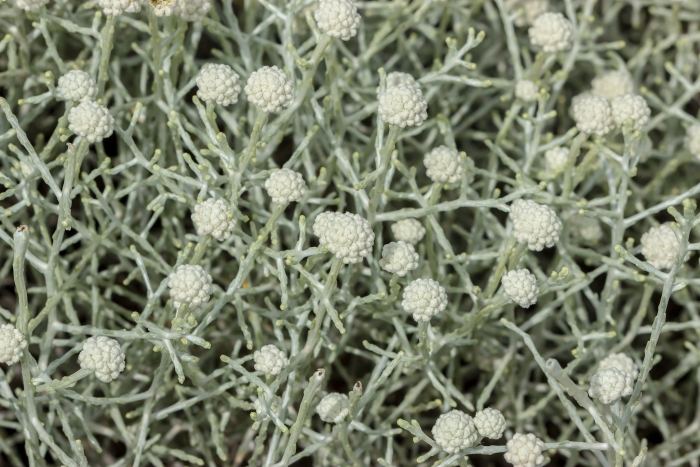Cushion Bush
(Calocephalus brownii)
Cushion Bush (Calocephalus brownii)
/
/

Andrew Allen
CC BY 4.0
Image By:
Andrew Allen
Recorded By:
Copyright:
CC BY 4.0
Copyright Notice:
Photo by: Andrew Allen | License Type: CC BY 4.0 | License URL: http://creativecommons.org/licenses/by/4.0/ | Rights Holder: Andrew Allen | Publisher: iNaturalist | Date Created: 2021-01-02T07:39Z |

























Estimated Native Range
Summary
Calocephalus brownii, commonly known as Cushion Bush, is an evergreen shrub native to coastal dunes and rocky outcrops in Southern and Western Australia. It typically grows to a height of 0.2 to 0.7 meters and is characterized by its silvery-grey foliage that provides a unique texture in the garden. The plant produces small, globular flower heads that are white to yellow and about 1 cm in diameter during the Australian summer, from December to February. Cushion Bush is notable for its hardiness, withstanding prevailing winds, sea spray, drought, and frost, making it an excellent choice for coastal gardens and harsh environments.
Cushion Bush is valued for its distinctive foliage and compact form, which makes it a popular choice for rockeries, borders, and as a ground cover in xeriscaping. It is also used in container plantings for its low maintenance and ability to thrive in poor soils. In cultivation, it requires full sun exposure and well-drained soil, preferably alkaline, to mimic its native coastal conditions. While it is drought-tolerant, occasional watering during extended dry periods can keep the plant looking its best. Overwatering or poor drainage can lead to root rot, so care should be taken to avoid these conditions.CC BY-SA 4.0
Cushion Bush is valued for its distinctive foliage and compact form, which makes it a popular choice for rockeries, borders, and as a ground cover in xeriscaping. It is also used in container plantings for its low maintenance and ability to thrive in poor soils. In cultivation, it requires full sun exposure and well-drained soil, preferably alkaline, to mimic its native coastal conditions. While it is drought-tolerant, occasional watering during extended dry periods can keep the plant looking its best. Overwatering or poor drainage can lead to root rot, so care should be taken to avoid these conditions.CC BY-SA 4.0
Plant Description
- Plant Type: Shrub
- Height: 0.6-3 feet
- Width: 0.6-3.2 feet
- Growth Rate: Moderate
- Flower Color: Yellow
- Flowering Season: Spring, Summer
- Leaf Retention: Evergreen
Growth Requirements
- Sun: Full Sun
- Water: Low, Medium
- Drainage: Fast
Common Uses
Bank Stabilization, Drought Tolerant, Fragrant, Low Maintenance, Potted Plant, Rock Garden, Salt Tolerant
Natural Habitat
Coastal dunes and rocky outcrops
Other Names
Common Names: Ghost Bush, Skeleton Bush, Silver Bush
Scientific Names: , Calocephalus brownii, Leucophyta brownii, Leucophyta brownii var. candidissima, Leucophyta brownii var. brownii, Leucophyta brownii var. virescens,
GBIF Accepted Name: Calocephalus brownii (Cass.) F.Muell.